S.S.
Toscana of the Lloyd
Triestino Line
Please Note: Firefox and some other Search Engines may not be suitable
Use Google Chrome for this Web Page to load perfectly!

Please Note: All ssMaritime and other related maritime
sites are 100% non-commercial and privately owned, thus ssmaritime is NOT associated
with any shipping company or any other organisation! Although the author has
worked and been involved in the passenger shipping industry for well over 60
years, but due to his old age and poor health, he was forced to retire. Yet, he
has completed well over 1,365 Classic Liners, Passenger-Cargo Liners as well as
humble converted C3 converted Migrant Liners, which has transported countless
thousands folk to the new world, as well on vacations’. I trust the
features online will continue to provide Classic Liner and Ship enthusiasts
both the information they are seeking, but more so provide a great deal of
pleasure and relive many happy memories!
Please
Note: Postcards, photographs & other images are
either from the author’s private collection, unless stated otherwise. A special thank you to ssmaritime supporters who
have sent in various photographs.
With Reuben
Goossens
Maritime
Historian, Cruise‘n’Ship Reviewer, Author and Lecturer
Commenced
in the Passenger Shipping & Cruise Industry in 1960
Lloyd Triestino
Line
SS Toscana
Built as the North German Lloyd
SS Saarbrücken
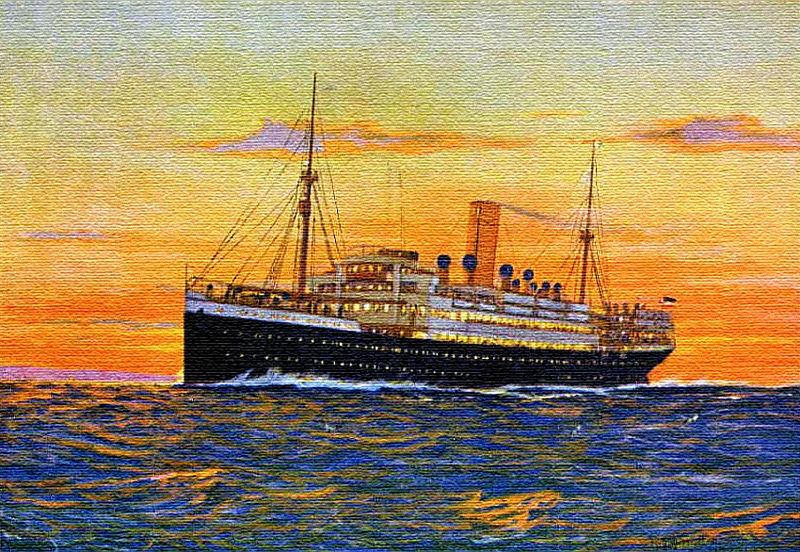
A painting of the German
built liner SS Saarbrüchen,
being the ship that became the SS
Toscana
Page One
The Ships History
Page
SS Toscana was originally built
as part of a series of new German ships known as the “Weser Class”
of ships and she and a sister were built for the Norddeutscher Lloyd named the Coblenz
and Saarbrücken in 1923. As built, both ships had accommodations for 98 First
Class and 142 Second Class passengers. When completed they were registered as
being 9,429 GRT (Gross Registered Tons) and they were placed on the rather
glamorous Bremen
to the Far
East service. However, in 1935 Norddeutscher
Lloyd had built three new
18,000-ton liners to operate on this service and they were capable of an
excellent service speed of 21 knots, rather than the slow 12.5 knots of the
older ships. Thus the decision was made that these twelve-year old liners would
be placed on the market and were soon sold. The SS
Saarbrüchen was obtained by the
Italian Lloyd Triestino Lines.
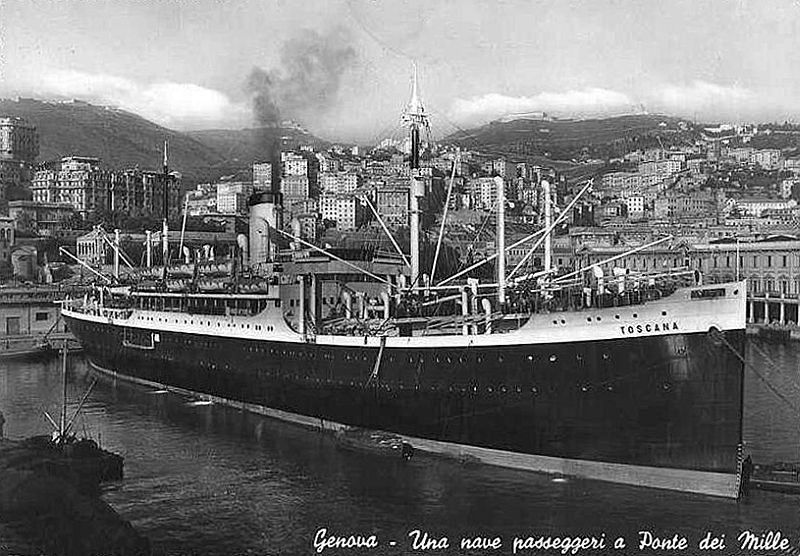
This
postcard of Toscana certainly made her look much more attractive than she
really was
It
is quite obvious that the hull ribbing and the sponsoon had been blacked out
Author’s
private collection
Although
it is not shown in most of the postcard or photographs of the ship, as they
were touched up by the company’s artist, as can be seen above and
reality, but one of the most notable things about this ship (and her sister)
was her ugly hull. Indeed her original profile may have been a standard
two-master, with an all white superstructure, thus a neat looking passenger
cargo liner with a tall slender funnel, but it was her hull that stood out for
being ugly! Her hull was corrugated from below the white top of her hull, all
the way down and to the water line where there was a massive amidships sponsoon
running along each side of the ship. These were designed to reduce the rolling
of the ship to a degree. In other words, it was the forerunner to the modern
stabilisers. However, there has never been an image produced of the Saarbrücken
that actually shows the sponsoon’s or a Lloyd
Triestino postcard in her earlier
days, for they blocked it out of all their photographs and postcards in order
to make the ship more likable and to attract passengers!
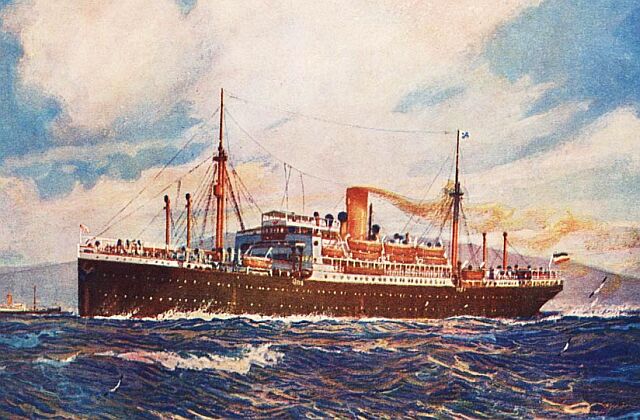
A
postcard of then luxurious Norddeutscher
Lloyd SS
Saarbrücken, but
again no sight of the corrugations or sponsoon
Author’s
private collection
Specifications:
Built: 1924 AG Weser,
Bremen,
Germany.
Sister
ships: Weser, Werra,
Coblenz II, Trier II, Fulda II.
Engines: Triple Expansion
Turbines by the builder.
Screws: Twin.
Speed: 12.5 knots.
Length: 480ft - 146m.
Beam: 146.3ft - 17.6m.
Tonnage: 9,429 GRT as built /
Toscana 1962; 9,584 GRT.
Passengers: 98 First - 142 Second /
from 1951 - 890 One Class.
Late in 1935 both ships were sold to the
Italia Government and placed them under the management of “Italia Flotte
Riunite” - the Italia Line. The SS Coblenz was named Sicilia and SS
Saarbrücken became the Toscana. At
first both operated as troop transports for one year and they were transferred
in 1937 to Lloyd
Triestino Line
who gave them a refit into the most humble migrant transport ships. The Toscana
was able to accommodate some 2,000 passengers in the most austere conditions,
some in cabins, but the vast majority of these were berthed in dormitories
located in the tween decks (holds), including where there once had been cargo
space. SS Toscana
was placed on the Italy
to South America service and later on the East and South
Africa
service.
In 1940 the Toscana and her sister were
converted into Italian flagged Hospital ships hey received an all white livery.
Although she still had the standard German profile and she now looked like an
all white passenger cargo ship and amazingly, out of the two ships, only the
Toscana survived the conflict and she was just one of a few of the Italian
ships to survive the WWII in one piece!
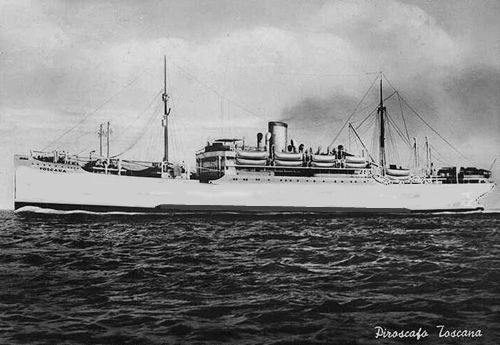
SS
Toscana
seen here touched up with a white hull and the sponsoon added in grey,
as the original image was
in black without the sponsoon
Author’s
private collection
In
September 1943 the SS Toscana
was taken over by the Allied forces, but she was returned to the
Italian’s in 1945, and she was handed over to Lloyd
Triestino in 1947, who gave her a
much-required refit.
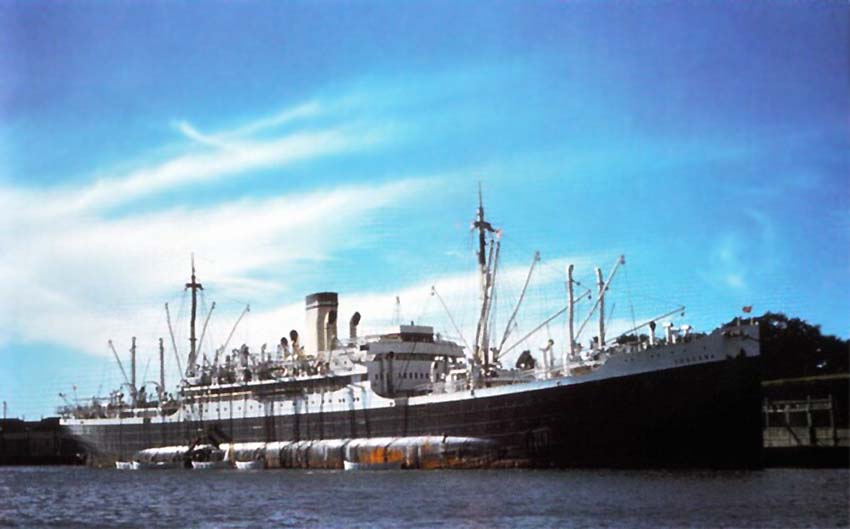
Lloyd Triestino’s
Passenger Cargo Liner SS Toscana is seen after her post war refit
Here we see that hideous Sponsoon along both sides of
her hull
Photograph
sent in by a supporter
Toscana’s
refit would see her change dramatically internally as well as externally with
bulbous sponsoon’s added to aid her stability. Her hull was thankfully
repainted black again in addition her funnel was lengthened. She now offered
accommodation for 136 passenger in Saloon Class and 690 in Third Class, thus
she was not as crowded. Saloon Class offered mostly two and four
berth cabins with comfortable and very attractive Lounges, bars and a spacious
dinning room. Whilst Third Class was a little more basic having six berth
cabins as well as some large dormitories down in the holds for the migrant
trade. In addition her lounges were more modest, but quite pleasant. Upon
completion she returned to service operating voyages between Italy,
Egypt
and South
Africa.
The Gerald
Buttigieg
Story:
I received an email from Gerald
Buttigieg,
whose Father sailed on the QSMV Dominion Monarch from Port
Said to Durban
1947. He also told me about his Mother’s voyage accompanied by his
nine-year old sister and himself on the S.S.
Toscana
from Port
Said to Durban
on August 10, 1948, and a later he sent the following as well as the ticket and
relevant newspaper clippings related to his rather interesting story.
“We departed Port
Said on the iconic S.S.
Toscana,
from what I gather was a ship that took countless of immigrants from Italy
and Egypt
to Australia
via Durban
in the early 50 and 60’s. I understand she was originally the German
liner Saarbrücken. My mother, sister and I left Port
Said on
August 10, 1948, and we sailed “Dormitory Class.” My mother saved
the ticket which I still have. We arrived in Durban
on September 3, 1948 and upon arrival the ship was quarantined outside Durban
Harbour
due to an outbreak of typhoid on board the ship. Apparently there were some
deaths en route and apparently there had been some burials at sea. At the time
I was only five years of age at the time. But I did manage to obtain some
newspaper clippings going back to the Toscana’s arrival in Durban
that confirms the quarantine and its actual arrival. In my research I also
found a diary of a passenger who boarded in Venice
and wrote up a day-by-day diary. He sadly contracted typhoid and was gravely
ill on arrival in Durban
and sadly he died three days later.
Gerald Buttigieg.
South
Africa.”
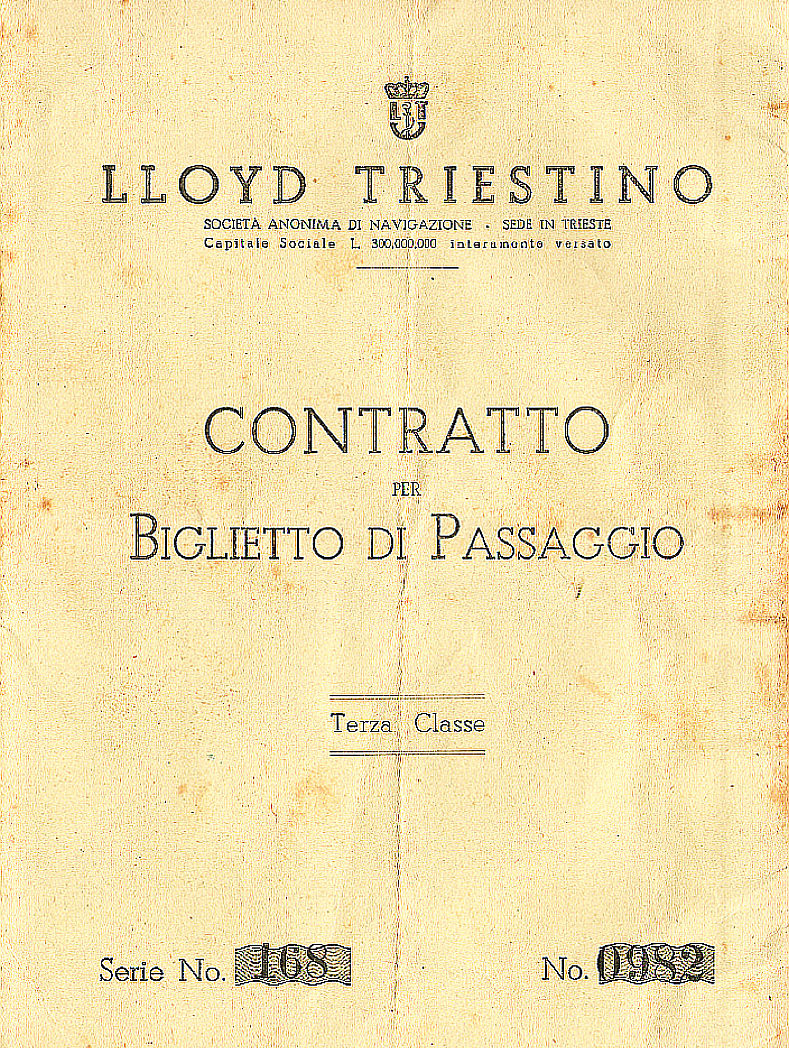
Lloyd Triestino
ticket cover
Provided by Gerald
Buttigieg
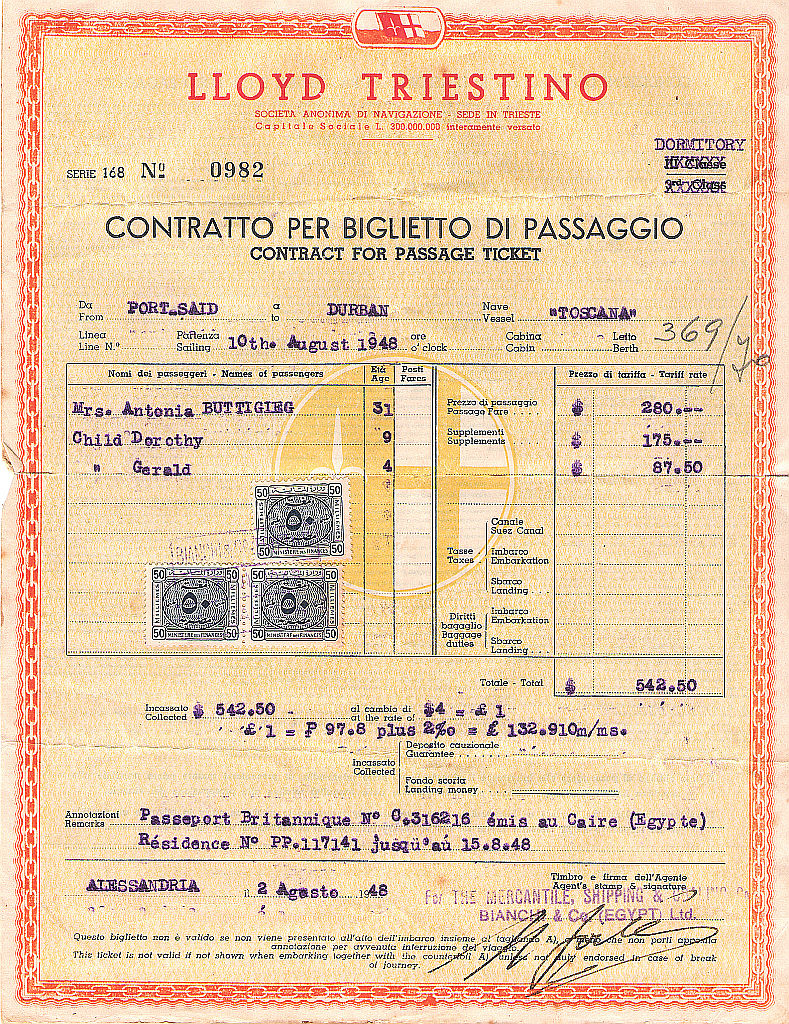
The
Buttigieg family ticket on the Toscana
Provided
by Gerald Buttigieg
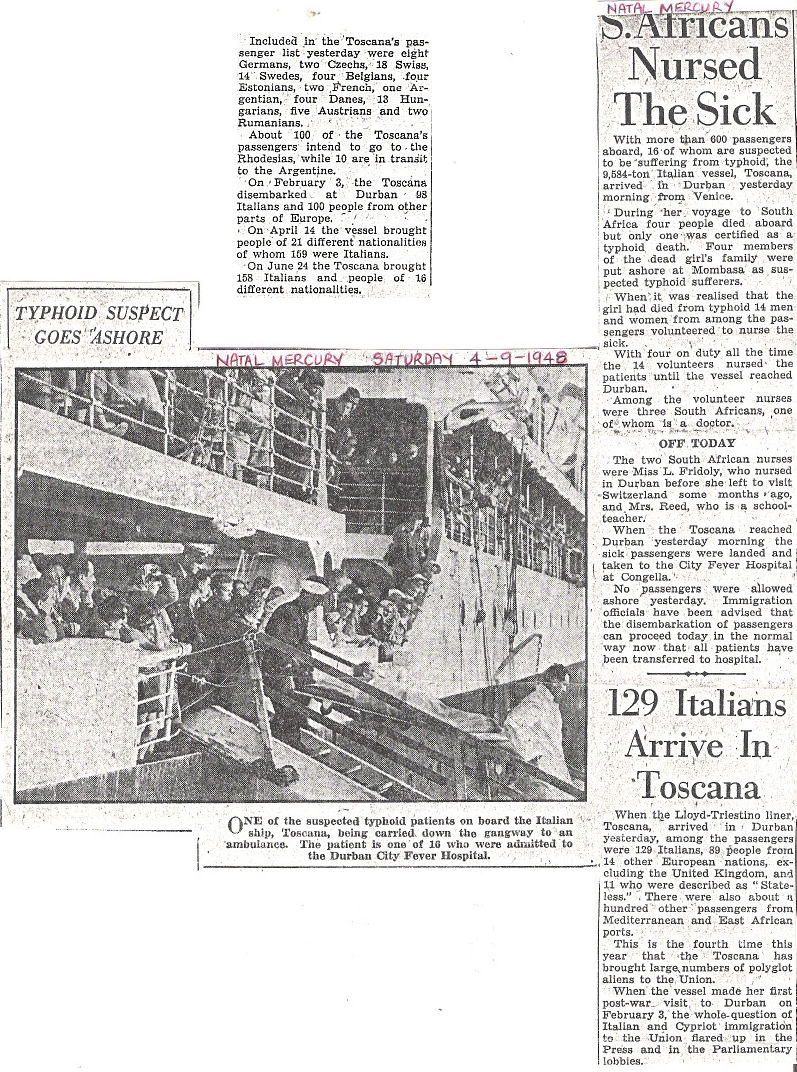
Articles
in the Natas
Mercury regarding the typhoid on
board the Toscana
Provided
by Gerald Buttigieg
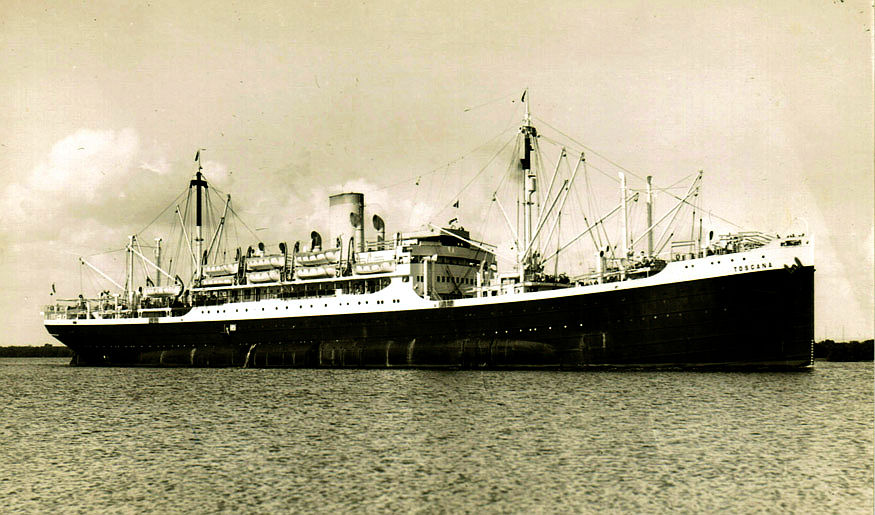
A
fine view of the ship
Author’s
private collection
Having
operated her on the South
Africa
service it would be on October 19, 1948, when Toscana commenced her new career
as she departed Genoa
on her first voyage to Australia,
arriving in Melbourne
on November 30, and Sydney
on December 2.
On this maiden voyage to Australia
was the then 22 year-old Mrs
Mabel Shelling,
her husband and their 14 months old daughter Anne,
bound for Sydney.
You can read their full story and photographs, as well as a brochure and
passage ticket on Page Two.
Gallery - S.S. Toscana
Departure from Genoa:
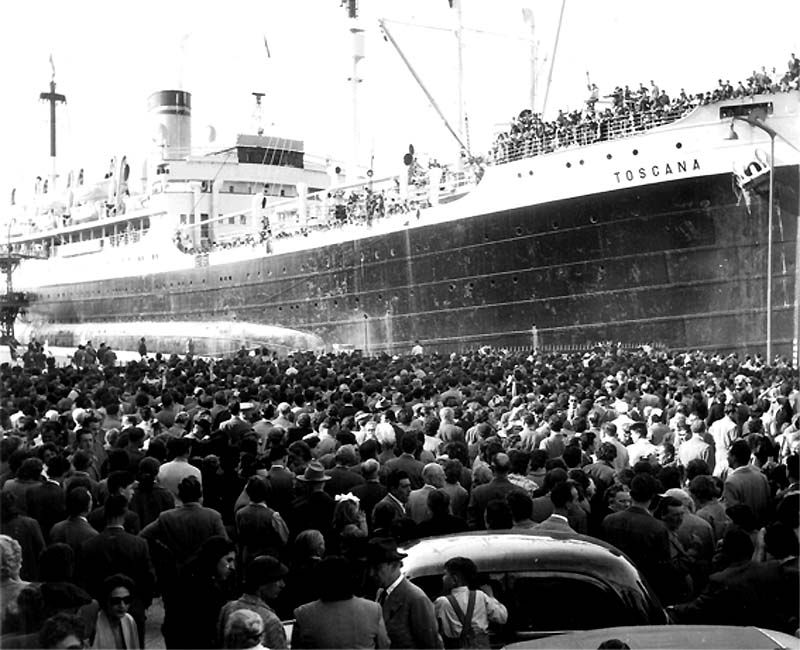
Passengers have boarded and the Toscana is
awaiting clearance to depart
Note her ribbed hull, which is quite visible
in this photograph
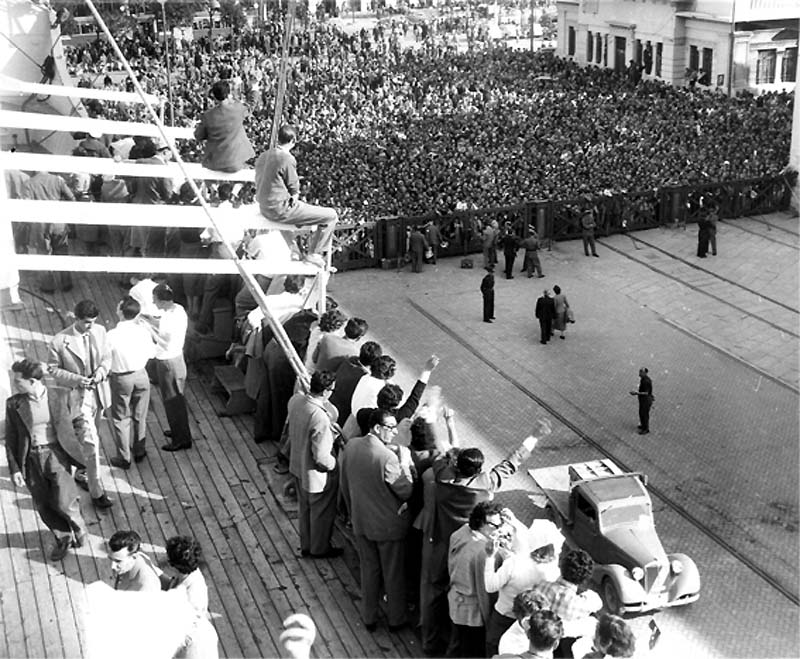
Dormitory Class passengers are seen on the
aft deck-waving goodbye to whoever was able to come to the port
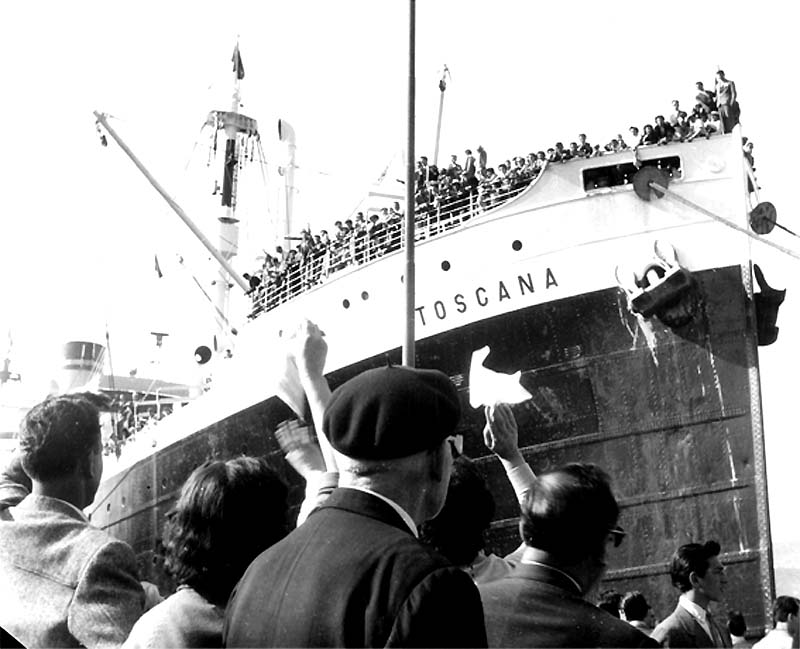
The Toscana is pulling from the wharf and the
long voyage to Australia
has commenced!
It was during this time many Europeans
refugees would come to Australia
in Dormitory Class on various ships including the S.S.
Toscana.
Many came from Slovenia
and other East
European countries one of these was a young girl
named Anita, who wrote the following;
“I sailed to Australia
on the liner S.S.
Toscana.
The voyage took around 42 days. My accommodation was in a top bunk in what was
rather primitive dormitory catering for 100 women, whilst another dormitory
catered for the men. Yet, there were cabins available for families of four or
six. Sadly, I was left without any supervision, but I do remember that one
of the crew paid me some extra attention, and he was getting far to close into
my personal space. As a naïve teenager, I began to feel intimidated and
uncomfortable. My instinct told me this was not normal, therefore I began to
avoid him. Only years later did I become aware of dangers that I could have
been exposed to, had I not followed my gut feelings.
The most memorable events on my trip were
seeing for the first time all those black people in Port
Said and travelling through Suez
Canal, and then there were all
those half-starved cows staring at us as the ship slowly passed by. To a naïve
thirteen years old, all this was all very intriguing.”
For a girl so young, this must have been a
perilous voyage for it appears she was travelling alone and without any supervision
and as her writings prove, tragically there will always be evil inclinations in
some men, and the may attempt to take advantage of a young person like her, but
thankfully, she was wise! Out of all the crews of the world there are two
nations that have proven to be the worst when it came to such matters, although
they did happen just occasionally, but even that is far too much!
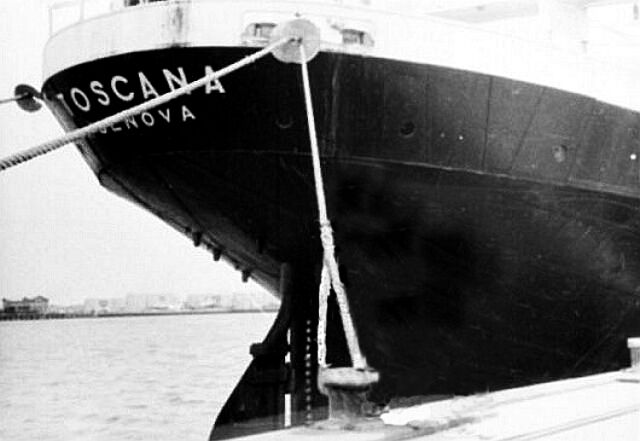
She
did have a wonderful counter style stern!
Author’s
private collection
In 1949 she was joined by several
other Lloyd Triestino
ship, such as the Sebastiano Cabato
and Ugolino Vivaldi
and together these three ships maintained the Lloyd
Triestino presence in Australia.
However, with passenger number being healthy Lloyd
Triestino had built three modern
new sleek passenger-cargo liners with the finest and most modern facilities,
including excellent Tourist Call public venues and accommodations! These ships
commenced in 1951 and were named the MS Australia,
Neptunia and Oceania.
With these three new liners on the scene they replaced the S.S.
Sebastiano
Cabato and Ugolino
Vivaldi, whilst the S.S.
Toscana
would receive yet another refit in Italy.
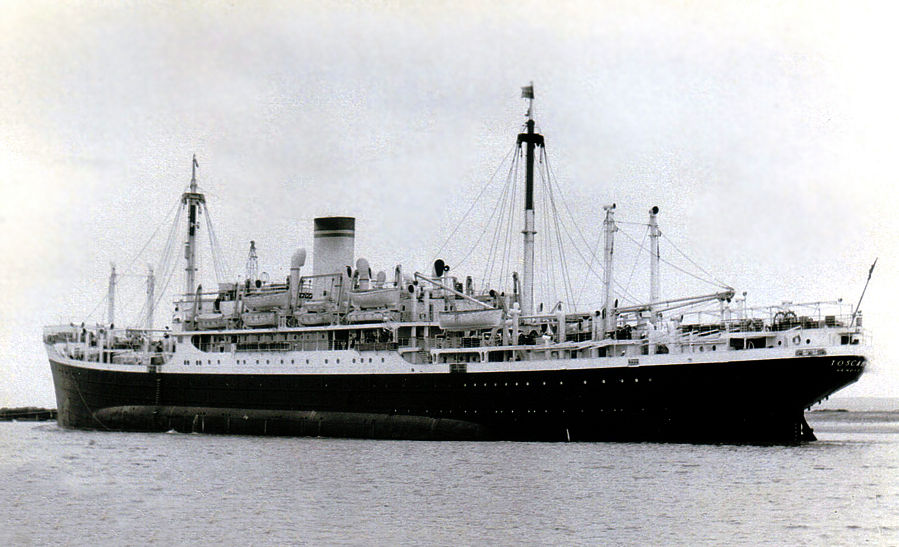
Toscana
certainly looked somewhat better from astern
Photograph
by J.Y. Freeman
- from the Rich
Turnwald collection
Late in 1951, the Toscana received a rapid
refit in order for her to become a One Class liner catering for just 819
passengers, thus giving all her passengers the run of the ship, being able what
were the First/Cabin Class luxurious Lounges, Bars, spacious decks and Dining
Room. At last the passengers had wonderful spaces to explore, for the truth was
that she was indeed a high quality ship, but these new parts had always been
for the privileged few. Although things would be very different then it had
been previously, for she would sail from Italy to Australia filled to capacity with
migrants, however on her homeward voyage she would mostly operate as a cargo
ship with her six holds full of cargo and without any passengers, however,
there were occasions, during high traffic times that the Toscana would take
fare paying guests on board whilst sailing from Australia to Italy.
*************************************
S.S. Toscana collision at
Port Suez
By the late Mr.
John
Hallam.
“On February 5, 1953, the day after my
wife Lorraine
and I were married, we boarded the S.S.
Toscana
at the port
of Fremantle
on the west coast of Australia.
Her destination was Brindisi
on the east coast of Italy.
However sadly she never reached her destination.
The “Toscana” was carrying cargo
and passengers and many of them were Italian and Maltese migrants being
deported because they had rioted in Sydney after as they claimed the Australian
Government having failed to provide them with the jobs they had been promised.
During her voyage we called in at Singapore,
Colombo
and then it was off to Aden,
but our Captain suddenly received instructions to divert to Massawa in Eretria
in order to collect some unscheduled cargo.
Once we departed Massawa the
“Toscana” headed for the Suez Canal, but when she was approaching
the port of Suez there were several ships converging in haste towards the
entrance of the canal for their last opportunity to join the convoy that was
about to enter the Canal.
And considering the rather dim light of dusk,
the American “Transport Oiler”, the U.S.N.S.
“Cowanesque” (T-AOT-79) collided with the “Toscana”
opening up a three deck high gaping hole in her side.
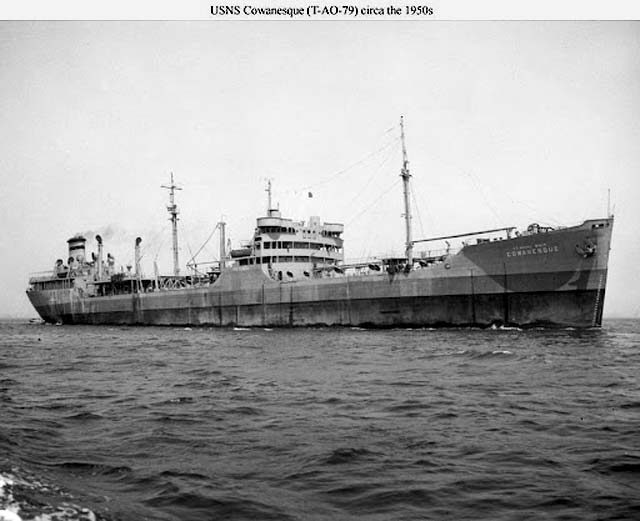
U.S.N.S. “Cowanesque”
(T-AOT-79)
Authors private collection
Several massive holes opened up near a cargo
hold, as well as an outside cabin and the dining room which passengers had
vacated only 30 minutes earlier. However, there was also considerable damage
done to her Bridge.
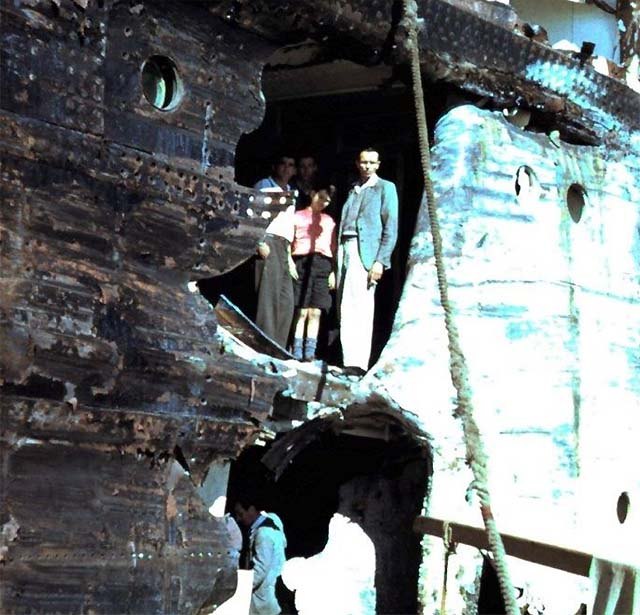
Above & below: Two
photographs of the damage caused to her hull and the Bridge
Photographs by John
Hallam
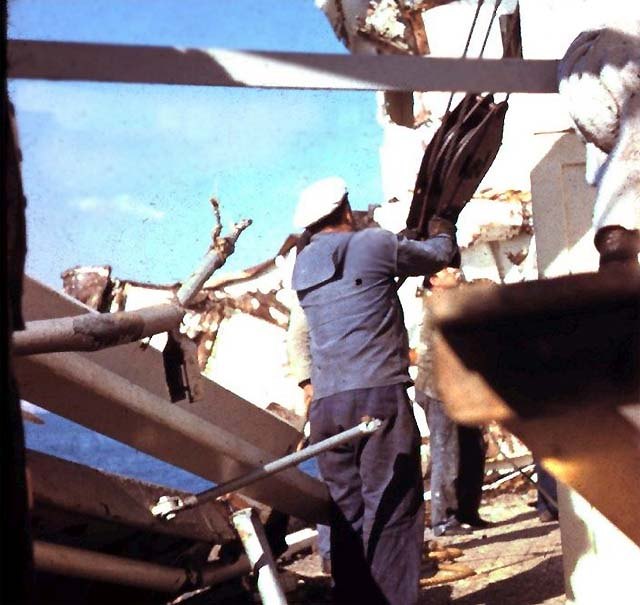
At the time of the collision, waiters who were
polishing silverware at the back of the dining room were in a state of shock
and were the first on deck. I was outside my cabin desperately asking fleeing passengers
where they were finding their life jackets. They had learned that they were
under their bunks during an emergency drill that was strangely practiced only
between Sydney
and Fremantle, thus we missed out. One of the passengers on an upper bunk, hearing
the Cowanesque’s warning horn and seeing her through a porthole as she
approached, jumped to the other side of the cabin and he survived. The Maltese
passenger lying on the bottom bunk was unfortunately killed.
The bottom deck was below the water line thus
she was taking in water fast. But bags of wheat in the cargo hold, we were
told, helped to stem the flow of water, thus this together with the pumps they
managed to keep the ship afloat. After a week in stifling heat and in our now
non air-conditioned cabins, most of the passengers were finally sent by train
to Port Alexandria on the Mediterranean coast where we boarded the superior and
more modern liner the S.S.
Esperia.
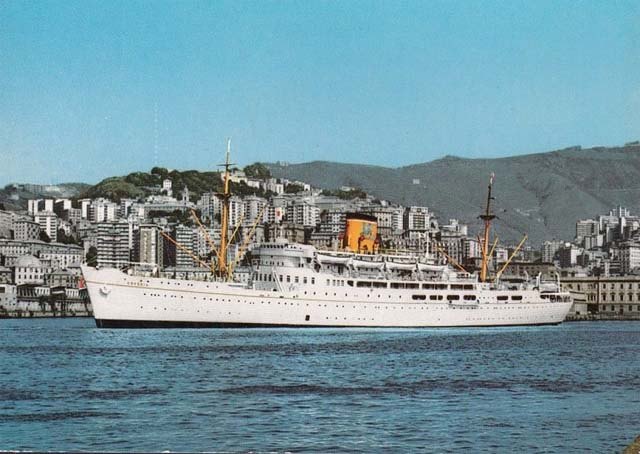
Adriatica Line’s S.S.
Esperia
Authors private collection
We sailed via Beirut,
Bari,
Brindisi,
Venice,
Trieste disembarked at Naples
and we continued our journey to London
by train. However, the troublesome rioters were sent on a non-stop voyage to Italy
on a ship named “Diana”
sailing through the Suez
Canal”.
John
Hallam.
Please Note: The above excellent story written
by Mr Hallam
was slightly edited by the author of ssMaritime, for clarity reasons.
*************************************
Harry’s Experience:
I received an email from a passenger who
sailed on the Toscana in 1955 being a young 7 year-old boy who with his parents
sailed from Fremantle to Genoa;
sailing via Colombo,
Aden,
Port Suez, and Port
Said,
being a five week voyage.
“I was a frightened 7 year-old when I
boarded in Fremantle for the six-week journey to Italy. I
well remember the sponsoon’s and my father telling me they were to stop
the ship rolling on high seas. I can remember there were a lot of other
people on board and we enjoyed the food. Crossing the equator was scary as
they had Captain Neptune
sitting in judgement and punishing passengers for trumped up charges by
splattering them with eggs and rubbish from the kitchen then ordering them
thrown in the swimming pool. The swimming pool was a large wooden crate and
around 6 m x 10 m x at least a metre deep. It was lined with a huge canvas
tarpaulin. The ship anchored in the ports we visited, and I still have
coins from some of these ports. In December 1955 we returned to Fremantle (the
port for the city of Perth)
on the P&O liner S.S.
Stratheden,
which was a much larger and a faster ship, and we departed from Tilbury and
sailed via the Suez
Canal to Fremantle. Being
a faster ship she reached Fremantle in around a month.”
Harry Pearson,
Western
Australia.
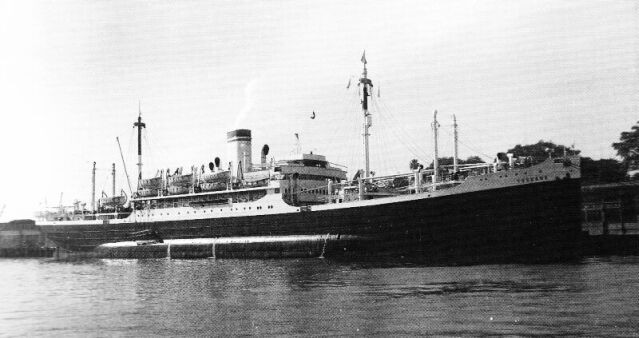
She
is seen here late in 1959
Photograph
sent in by a supporter
Toscana operated on her new schedules, being a
one-way passenger liner to Australia
and an all cargo ship to Genoa,
however by the 1960’s she was taking paid passengers back to Italy from
Australian ports.
S.S. Toscana
& “The Rip” Tragedy in February 1960:
There was one departure from Melbourne
in the afternoon on February 17, 1960 being a warm, calm and a pleasant day
that would place the Toscana in history as she was involved in a remarkable
rescue of commandos whilst they were on an evening exercise near the Port
Phillip Bay Heads in two men kayaks and inflatable zodiacs. During the exercise
suddenly a massive storm took everyone by surprise and many were swept into the
sea and even into the treacherous The Bay entrance’s “Heads”
also known as “The Rip” where two men quickly died. Later another
also died, a commando who helped eight men to board the Toscana who came to the
rescue being nearby and its crew had thrown a ladder and ropes down the side of
the ship, and this one man aided his eight companions up the wildly moving
ladder, whilst holding zodiac and the ladder steady as much as possible with
both his hands, whilst both the ship and the zodiac was heaving wilding in
eight meter waves, but sadly at the end he was thrown of the ladder into the
sea well past the wild “Rip” when he attempted to board the Toscana
and the ladder smashed against the hull and went out and twisted and sadly he
was never seen again, thus this hero died saving his mates! The full story can
be found on the Index at the bottom of this page; Page Three: S.S.
Toscana
“The Rip” Tragedy.
Her Final Days:
After the February voyage S.S.
Toscana
continued her voyages to Australia,
but her very last Australian voyage saw her arrive in Fremantle (port for Perth
Western
Australia) on October 17, 1960.
She would have continued as far as Sydney,
therefore she would have returned home to Italy
later in October for her final voyage from Australia.
She operated some further voyages for Lloyd
Triestino, but she was taken out of
service late in 1961, and she was laid waiting to be sold to a ship breaker.
She was soon sold to a local breakers yard, located in Genoa
and she arrived at their yard on February 21, 1962 and was rapidly broken up.
In
Conclusion:
The S.S.
Toscana,
ex Saarbrücken had given 39 years of faithful service to both Germany
and Italy.
She may not have been a luxury liner, far from it for she certainly did not
offer the migrants on board any kind of luxury in their accommodations, which
were less than desirable in many ways, although fare paying passengers did have
reasonably good accommodations and pleasant facilities.
The Toscana was far from the best-looking ship
around, with her ribbed hull and those hideous sponsoon’s along both sides
of her hull, but one thing was definite, she was one of the most
reliable ships sailing the seas!
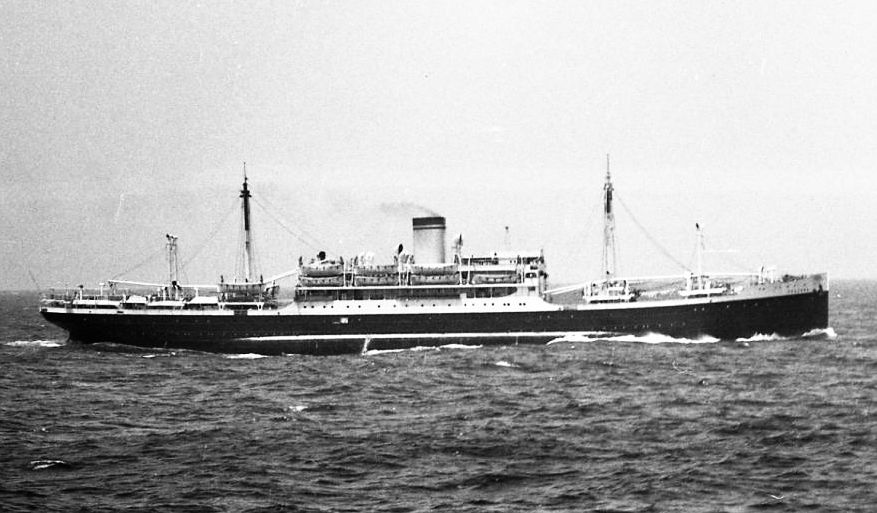
S.S.
Toscana
seen during her final voyage back to Italy
on the Indian
Ocean
in 1960
Author’s
private collection
Regardless
of the Toscana’s shortcomings she provided thousands of migrants and
passengers many fond memories of their voyage, even though she was an extremely
humble ship and far from a luxury liner, but, she plied the seas and brought
countless Italians and Europeans and others to various destinations, a new land
be it as migrants or tourists. So many people commenced a new life in their new
found home. I have received many emails over the years and there are those who
speak fondly of the old Toscana, and yes, she may have been rough on the edges
and I have received countless seasick stories, but the majority tend to say
that she had a character of her own, and as I have been told, the food was
always very good.
But there were some negatives due to illnesses
and even deaths as can be read above in Mr.
Gerald Buttigieg’s
story. There may even have some rat’s on board and they do come on whilst
a ship is in port of course, but that is a curse and it will cause many
problems, especially for passengers who are berthed in the tween (the ships
hold’s) dormitories! But over all, most of the stories I have received
are relatively positive for what was one of the most humble migrant - passenger
ships!
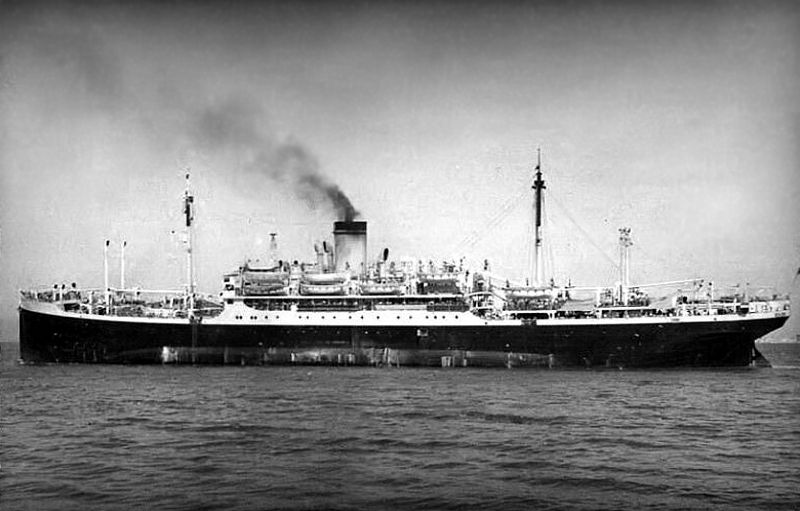
Toscana
is seen her during her final days
Author’s
private collection
S.S.
Toscana
INDEX:
Page One S.S. Toscana
History.
Page Two Family Shelling sailed on Toscana’s maiden voyage to Australia
in 1948.
Page Three S.S.
Toscana
“The Rip” Tragedy - February 17, 1960.
*************************************
Other Lloyd
Triestino
Liners on ssMaritime:
MS Australia and Oceania
& Neptunia
TN Galileo & Marconi & MV Africa & Europa
*************************
“Blue Water
Liners sailing to the distant shores.
I
watched them come, I watched them go and I watched them die.”

Featuring over 1,365
Classic Passenger Liners, Passenger-Cargo Liners & Classic Cruise Ships!
Or ENTER HERE
For interest:
Sadly an email service to ssMaritime is no longer available, due to the author’s
old age and chronic illness as well as being disabled, etc. In the past
ssMaritime received well over 120 emails per day, but Mr.
Goossens
can no longer handle same. He sincerely regrets this!
*************************
ssMaritime.com & ssMaritime.net
Where the ships of the past make history & the 1914 built M.S. Doulos Story.
The Author has
been in Passenger Shipping & the Cruise Industry for well over 60 years
In addition he was
the founder of “Save the Classic Liners Campaign” in 1990.
Please Note: ssmaritime and associated sites
are 100% non-commercial and the author seeks no funding or favours of
any shape or form, never have and never will!
Photographs
on ssmaritime and associate pages are by; the author or from the author’s
private collection. In addition there are some images that have been provided
by Shipping Companies and private photographers or collectors. Credit is given
to all contributors. However, there are some photographs provided to me without
details regarding the photographer/owner concerned.
This notice
covers all pages; although,
and I have done my best to ensure that all photographs are duly credited
and that this notice is displaced on each page, that is, when a page is updated!
ssMaritime is
owned & © Copyright by Reuben Goossens -
All Rights Reserved






















